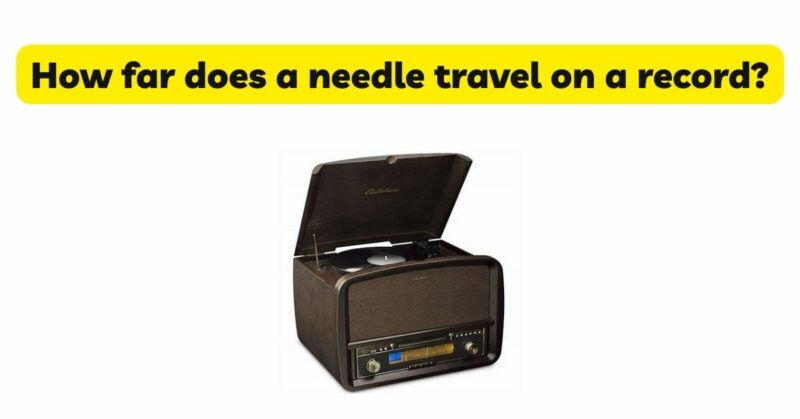Vinyl records have captivated music lovers for generations, providing a unique listening experience characterized by warm tones and tangible nostalgia. A fundamental aspect of this experience is the journey of the needle as it traces the grooves on the record’s surface. In this article, we will delve into the mechanics of a turntable’s needle travel, exploring the distance covered, the intricacies of groove navigation, and the factors that influence the needle’s path. By understanding the needle’s journey, we can gain a deeper appreciation for the technical intricacies and the artistry of vinyl playback.
- The Spiral Groove: Vinyl records are characterized by spiral grooves etched into their surface. These grooves contain the audio information in the form of variations in depth and width. As the needle moves along the grooves, it encounters these modulations, translating them into electrical signals that are then amplified and played through speakers.
- Linear vs. Angular Velocity: When a turntable is spinning, the linear velocity of the needle varies depending on its position on the record. The linear velocity is the actual speed at which the needle travels across the record’s surface. The outer edges of the record have a larger circumference, resulting in a higher linear velocity, while the inner sections have a smaller circumference and a lower linear velocity.
- Diameter and Travel Distance: The diameter of a vinyl record affects the needle’s travel distance. The larger the diameter, the longer the distance the needle must travel to complete one revolution. A typical 12-inch record has a diameter of approximately 30 centimeters (12 inches), while a 7-inch record has a diameter of about 17.5 centimeters (7 inches). The actual travel distance of the needle depends on the groove configuration, the duration of the record, and the playback speed.
- Playback Speed and Needle Travel: The playback speed of a record determines the needle’s travel distance per unit of time. The standard playback speeds for vinyl records are 33 1/3 revolutions per minute (RPM) for albums and 45 RPM for singles. At 33 1/3 RPM, a 12-inch record completes one full revolution in approximately 1.8 seconds, resulting in a linear travel distance of about 94 centimeters (37 inches). At 45 RPM, a 7-inch record completes one full revolution in approximately 1.3 seconds, covering a linear distance of around 57 centimeters (22 inches).
- Groove Variations and Needle Path: Vinyl records feature groove variations that dictate the needle’s path. The depth and width variations in the grooves correspond to the recorded audio signals. As the needle traverses the grooves, it moves laterally and vertically, following the groove modulations accurately. The stylus is designed to pivot and ride these variations, ensuring accurate tracking and optimal sound reproduction.
- Tracking Force and Needle Stability: The tracking force, the downward pressure exerted by the stylus on the record’s surface, plays a crucial role in the needle’s stability and accurate tracking. The tracking force must be set correctly to ensure that the stylus maintains contact with the groove walls without excessive pressure. Insufficient tracking force can cause the stylus to lose contact with the grooves, resulting in skipping, while excessive tracking force can cause unnecessary groove wear and compromise sound quality.
- Record Condition and Needle Travel: The condition of the record surface influences the needle’s travel. Scratches, dust particles, or other imperfections on the record can affect the needle’s movement, potentially causing skips or disturbances in playback. Regular cleaning and proper handling of records help maintain their surface integrity, allowing for smooth and accurate needle travel.
- Turntable Design and Mechanisms: Different turntable designs incorporate various mechanisms to ensure proper needle travel. These mechanisms include tonearm balance, anti-skate mechanisms, and vertical tracking angle adjustments. These features help maintain the stylus’s optimal alignment and tracking, ensuring accurate playback and minimizing excessive wear on the grooves.
- The Impact of Record Length: The length of a record affects the needle’s travel distance. Longer records, such as double albums or extended play records, require the needle to travel a greater distance to complete the playback. This extended travel may result in increased wear on the grooves, emphasizing the importance of proper stylus care and maintenance.
- The Journey Continues: As the needle completes its journey across a vinyl record, it leaves behind subtle traces of its passage. The act of tracking the grooves, encountering the nuances of the music, and translating them into audible signals is an intricate dance between the needle, the record, and the playback system. Understanding the intricacies of this journey enhances our appreciation for the craftsmanship and engineering behind vinyl playback.
Conclusion: The needle’s travel on a vinyl record encompasses a fascinating interplay of mechanics, precision, and artistry. The distance covered by the needle depends on the record’s diameter, playback speed, and groove variations. Proper alignment, tracking force, and turntable design contribute to accurate needle travel and optimal sound reproduction. As we engage in the journey of vinyl playback, we can marvel at the intricacies of the needle’s path and the rich musical experiences it delivers, reminding us of the enduring allure of analog audio and the joys of physical media.


